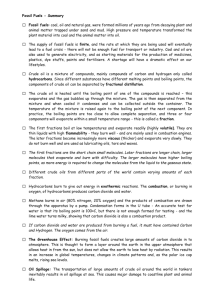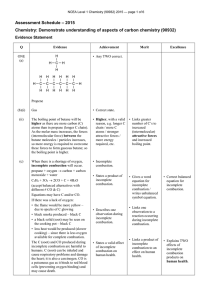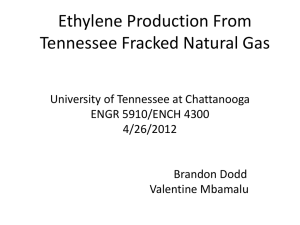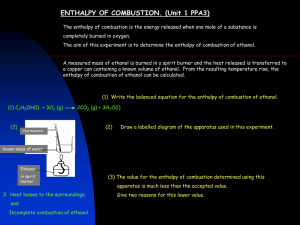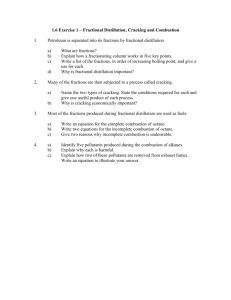101KB - NZQA
advertisement
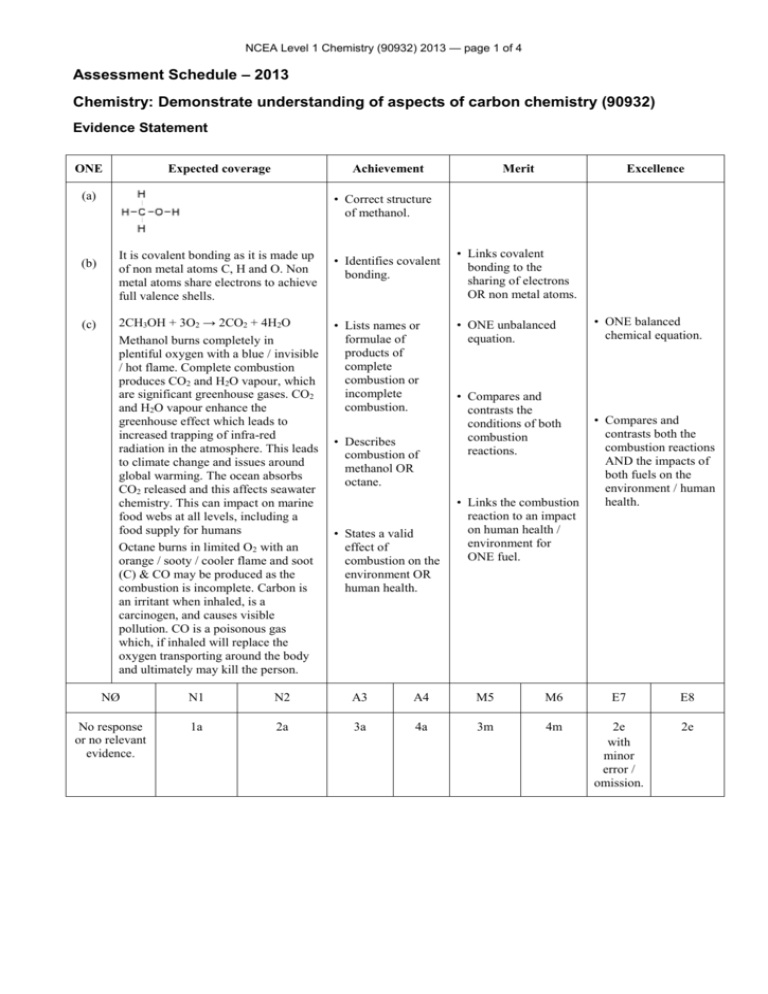
NCEA Level 1 Chemistry (90932) 2013 — page 1 of 4 Assessment Schedule – 2013 Chemistry: Demonstrate understanding of aspects of carbon chemistry (90932) Evidence Statement ONE Expected coverage Achievement (a) (b) (c) Merit Excellence • Correct structure of methanol. It is covalent bonding as it is made up of non metal atoms C, H and O. Non metal atoms share electrons to achieve full valence shells. • Identifies covalent bonding. 2CH3OH + 3O2 → 2CO2 + 4H2O Methanol burns completely in plentiful oxygen with a blue / invisible / hot flame. Complete combustion produces CO2 and H2O vapour, which are significant greenhouse gases. CO2 and H2O vapour enhance the greenhouse effect which leads to increased trapping of infra-red radiation in the atmosphere. This leads to climate change and issues around global warming. The ocean absorbs CO2 released and this affects seawater chemistry. This can impact on marine food webs at all levels, including a food supply for humans Octane burns in limited O2 with an orange / sooty / cooler flame and soot (C) & CO may be produced as the combustion is incomplete. Carbon is an irritant when inhaled, is a carcinogen, and causes visible pollution. CO is a poisonous gas which, if inhaled will replace the oxygen transporting around the body and ultimately may kill the person. • Lists names or formulae of products of complete combustion or incomplete combustion. • Describes combustion of methanol OR octane. • States a valid effect of combustion on the environment OR human health. • Links covalent bonding to the sharing of electrons OR non metal atoms. • ONE unbalanced equation. • Compares and contrasts the conditions of both combustion reactions. • Links the combustion reaction to an impact on human health / environment for ONE fuel. • ONE balanced chemical equation. • Compares and contrasts both the combustion reactions AND the impacts of both fuels on the environment / human health. NØ N1 N2 A3 A4 M5 M6 E7 E8 No response or no relevant evidence. 1a 2a 3a 4a 3m 4m 2e with minor error / omission. 2e NCEA Level 1 Chemistry (90932) 2013 — page 2 of 4 TWO Expected coverage Achievement Merit (a) Crude oil consists of a mixture of hydrocarbon molecules of different sizes which need to be distilled in order to separate into useful fractions, since the fractions have different uses. Fractions include: LPG (propane / butane) gas for heating and cooking; or octane / petrol and diesel for transport. Kerosene is another fuel and bitumen is used in roads. A tower is used because the crude oil is heated and the hot particles rise. Hydrocarbons of different molecular masses have different boiling points. Larger molecules have higher boiling points. When the heated crude oil vapour enters the tower, the larger, heavier hydrocarbons with the higher boiling points condense into liquids lower down in the tower, while the smaller, lighter hydrocarbons with the lower boiling points rise up the tower and condense back into a liquid at the lower temperatures near the top of the tower. The smallest hydrocarbons (C1 – C4) remain gases at room temperature, and exit from the top of the tower. The temperature at which a specific hydrocarbon condenses is related to its molecular mass, particularly the number of carbon atoms. The lower / higher its molecular mass is the lower / higher the temperature at which it will condense. This determines whereabouts on the tower the particular fraction is collected. • Describes crude oil as a mixture of (different sized) hydrocarbons • Explains that the crude oil needs to be separated into its fractions / different hydrocarbons to enable the fractions to be used. (b) (c) • Lists TWO fractions and describes a use. • Describes the process of fractional distillation. • Recognises the separation of the (lighter and heavier) fractions depends on differences in the boiling points. Excellence • Links the boiling point (condensation temperature) to where the fraction collects • Links the size of the hydrocarbon to where the fraction collects in the tower OR its boiling point • Links the process of fractional distillation to size of the molecules, the temperatures at which they change state, and their position of collection in the tower. NØ N1 N2 A3 A4 M5 M6 E7 E8 No response or no relevant evidence. 1a 2a 3a 4a 2m 3m e with minor error / omission. e NCEA Level 1 Chemistry (90932) 2013 — page 3 of 4 THREE Expected coverage (a) (b) Achievement Merit Excellence • Links the breaking of the double bond to the formation of a polymer. • Fully explains how the breaking of the double bond allows polymerisation AND that the alkane cannot due to it only having single bonds. • Links ONE property of polypropene relevantly to its named use • Links TWO properties of polypropene to each of TWO relevant named uses. • Draws partial structure of a polypropene molecule. Alkenes have a (reactive) double covalent bond between two carbon atoms. (Under high temperatures, high pressure and catalytic conditions) the double bond can be broken, resulting in a single covalent bond and a spare single bond that can covalently bond to the next monomer to form a long chain polymer. • Describes the process of polymerisation as monomers reacting to form a polymer. • States that alkenes have a double bond, and alkanes have a single covalent bond between carbon atoms. Alkanes have only single covalent bonds between carbon atoms, which are unreactive (in these conditions), so do not form polymers. (c) Identified valid uses are linked to properties such as: • low chemical reactivity (e.g. with air, water and living organisms). (But susceptible to UV degradation) • high tensile strength / strong • insolubility in water / does not absorb moisture • ability to be moulded or extruded into a wide range of shapes with moderate heating due to high melting point (about 160°C) • insulator • low density / lightweight and floats • recyclable. • Describes TWO uses of polypropene. • States TWO properties of polypropene. • Links ONE different property of polypropene relevantly to its named use. NØ N1 N2 A3 A4 M5 M6 E7 E8 No response or no relevant evidence. 1a 2a 3a 4a 2m 3m e 2e NCEA Level 1 Chemistry (90932) 2013 — page 4 of 4 FOUR Expected coverage (c) Merit Excellence • Links ethanol’s stronger attractions between molecules to the melting / boiling point OR to its state at room temperature. • Analyses the differences of chemical structure, state at room temperature, melting and boiling points and solubility in water between ethane and ethanol. • TWO correct structural formulae. (a) (b) Achievement Ethane has a lower melting / boiling point than ethanol because it has weaker attractions between the molecules, so does not need as much energy to boil. Ethane is a gas at room temperature. Ethanol is a liquid at room temperature Ethane as a gas is not soluble in water, as there are no attractions between ethane and water. Ethanol is an alcohol that is soluble in water because the (OH) part of ethanol is attracted to the water molecules. • Identifies ethane as a gas and ethanol as a liquid. Fermentation involves the conversion of a solution of sugar molecules (in water) into ethanol and carbon dioxide in warm, anaerobic conditions using yeast as a catalyst. Yeast is a living organism and requires warmth and moisture to carry out life processes. Yeast metabolises / converts the sugars to alcohol when it is starved of oxygen. The yeast dies when the alcohol levels become too high. • States TWO conditions of fermentation. • Recognises that ethane will have a lower melting / boiling point (or vice versa). • States that ethanol is soluble in water. • Identifies reactants and products. • Links solubility of ethanol or insolubility of ethane to attractions with water / functional group. • Links ONE material / conditions to the fermentation process. • Unbalanced symbol equation. • Explains the fermentation process which addresses the role of yeast in terms of materials and conditions required, and products formed. • Writes a balanced equation. C6H12O6 → 2C2H5OH + 2CO2 NØ N1 N2 A3 A4 M5 M6 E7 E8 No response or no relevant evidence. 1a 2a 4a 5a 3m 4m 2e with minor error / omission, including a balanced symbol equation. 2e Judgement Statement Score range Not Achieved Achievement Achievement with Merit Achievement with Excellence 0 – 10 11 – 17 18 – 24 25 – 32

